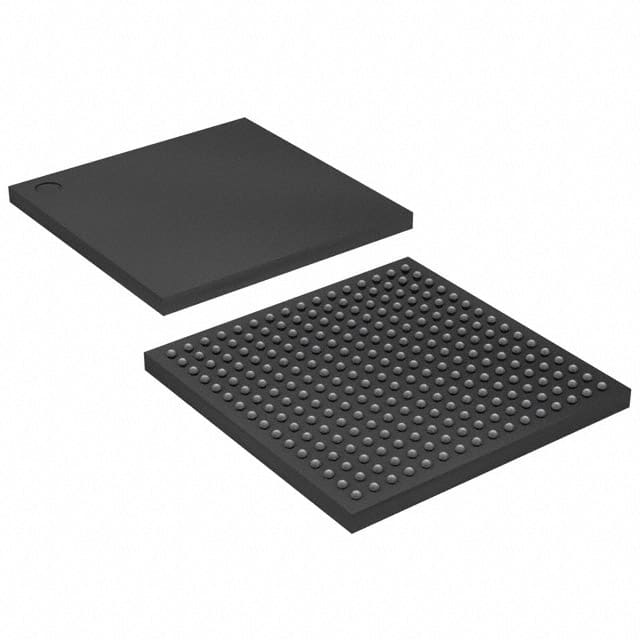EP4CE10F17C8
Product Overview
- Category: Programmable Logic Device (PLD)
- Use: EP4CE10F17C8 is a PLD used for digital logic design and implementation.
- Characteristics: It offers high performance, low power consumption, and flexibility in designing complex digital systems.
- Package: The EP4CE10F17C8 comes in a compact 256-ball FineLine BGA package.
- Essence: This PLD is designed to provide a cost-effective solution for various applications requiring programmable logic capabilities.
- Packaging/Quantity: The EP4CE10F17C8 is typically sold individually or in small quantities.
Specifications
- Logic Elements: The device contains 10,080 logic elements (LEs).
- Embedded Memory: It includes 414 kilobits of embedded memory.
- PLLs: The EP4CE10F17C8 features two phase-locked loops (PLLs) for clock management.
- I/O Pins: It provides 179 I/O pins for interfacing with external devices.
- Operating Voltage: The device operates at a voltage range of 1.15V to 1.25V.
- Speed Grade: EP4CE10F17C8 is available in different speed grades, such as -6, -7, and -8, indicating the maximum operating frequency.
Detailed Pin Configuration
The EP4CE10F17C8 has a specific pin configuration that allows for connectivity and integration within a larger system. For a detailed pinout diagram and description, refer to the manufacturer's datasheet.
Functional Features
- Flexibility: EP4CE10F17C8 offers a wide range of programmable logic resources, allowing designers to implement complex digital systems.
- Low Power Consumption: The device is designed to minimize power consumption, making it suitable for battery-powered applications.
- High Performance: With its high logic density and embedded memory, EP4CE10F17C8 can handle demanding digital processing tasks efficiently.
Advantages and Disadvantages
Advantages: - Versatile programmable logic capabilities - Low power consumption - High performance for complex digital designs
Disadvantages: - Limited logic elements compared to higher-end PLDs - May require additional external components for specific applications
Working Principles
EP4CE10F17C8 operates based on the principles of field-programmable gate arrays (FPGAs). It consists of configurable logic blocks (CLBs), interconnect resources, embedded memory, and I/O pins. The device can be programmed using hardware description languages (HDLs) or graphical design tools to define the desired functionality.
Detailed Application Field Plans
EP4CE10F17C8 finds applications in various fields, including but not limited to: - Digital signal processing - Communication systems - Industrial automation - Consumer electronics - Automotive electronics
The device's flexibility and performance make it suitable for a wide range of applications that require programmable logic capabilities.
Alternative Models
For alternative models with similar features and capabilities, consider the following options: - EP4CE15F17C8: Offers higher logic capacity and more embedded memory. - EP4CE6F17C8: Provides a lower-cost option with reduced logic capacity.
These alternatives can be considered based on specific project requirements and budget constraints.
Note: This entry provides a general overview of EP4CE10F17C8. For detailed technical information, refer to the manufacturer's documentation.
Lista 10 Vanliga frågor och svar relaterade till tillämpningen av EP4CE10F17C8 i tekniska lösningar
Sure! Here are 10 common questions and answers related to the application of EP4CE10F17C8 in technical solutions:
Question: What is EP4CE10F17C8?
Answer: EP4CE10F17C8 is a field-programmable gate array (FPGA) device manufactured by Intel (formerly Altera). It is part of the Cyclone IV E series and offers a range of features for implementing digital logic designs.Question: What are the key features of EP4CE10F17C8?
Answer: Some key features of EP4CE10F17C8 include 10,320 logic elements, 414 kilobits of embedded memory, 66 embedded multipliers, and support for various I/O standards.Question: What are the typical applications of EP4CE10F17C8?
Answer: EP4CE10F17C8 can be used in a wide range of applications such as industrial automation, automotive electronics, communication systems, medical devices, and consumer electronics.Question: How can EP4CE10F17C8 be programmed?
Answer: EP4CE10F17C8 can be programmed using the Quartus Prime software provided by Intel. The design can be implemented using either VHDL or Verilog hardware description languages.Question: Can EP4CE10F17C8 interface with other components or devices?
Answer: Yes, EP4CE10F17C8 supports various I/O standards such as LVCMOS, LVTTL, SSTL, and LVDS, allowing it to interface with a wide range of components and devices.Question: What is the maximum clock frequency supported by EP4CE10F17C8?
Answer: The maximum clock frequency supported by EP4CE10F17C8 depends on the design and implementation. It can typically operate at frequencies up to 200 MHz or higher.Question: Can EP4CE10F17C8 be used for real-time signal processing?
Answer: Yes, EP4CE10F17C8 can be used for real-time signal processing applications. Its embedded multipliers and dedicated DSP blocks make it suitable for implementing algorithms such as filtering, FFT, and image processing.Question: Does EP4CE10F17C8 support communication protocols?
Answer: Yes, EP4CE10F17C8 supports various communication protocols such as UART, SPI, I2C, and Ethernet. These protocols can be implemented using the FPGA's I/O pins and programmable logic.Question: Can EP4CE10F17C8 be used in safety-critical applications?
Answer: EP4CE10F17C8 can be used in safety-critical applications, but additional measures may be required to ensure functional safety. This can include redundancy, fault detection, and error correction techniques.Question: Are there any development boards available for EP4CE10F17C8?
Answer: Yes, there are development boards available specifically designed for EP4CE10F17C8. These boards provide easy access to the FPGA's I/O pins, power supply, and programming interfaces, making it convenient for prototyping and development.
Please note that the answers provided here are general and may vary depending on specific requirements and application scenarios.


